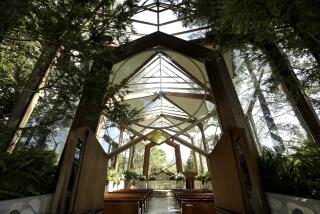Rescuing a Mission : Archeologist’s Arrival Signals Latest Phase in Preservation
- Share via
SAN JUAN CAPISTRANO — Standing amid the ruins of Mission San Juan Capistrano’s 187-year-old Great Stone Church, archeologist Frank Matero marveled Thursday at the immense human effort that went into building it.
“This was a huge undertaking. This is not rubble, these are not boulders,” said Matero, a visiting associate professor of architecture at the University of Pennsylvania, pointing to the three-foot-thick rock walls. “This is sandstone that had to be quarried somewhere nearby, carried here probably by oxcart, and then boosted up on the walls somehow. When it was built, it was undoubtedly the biggest building the California Indians had ever seen.”
Matero arrived in San Juan Capistrano this week to begin the newest phase of the mission’s 4-year-old, $25-million Third Century Preservation Project, conceived to safeguard the aging mission and all that is left of the church.
The sandstone, brick and mortar church was the grandest of all the churches built in early California’s system of 21 missions. It was completed in 1806, only to tumble during an earthquake on the infamous morning of Dec. 8, 1812, killing an estimated 40 worshipers.
“This is by far the most ambitious building constructed at its time,” said John C. Loomis, a preservation architect from Newport Beach who is helping oversee the project. “They would have pulled it off, if not for the earthquake.”
Unfortunately, the elements are continuing the church’s disintegration today.
A temporary network of steel straps and scaffolding similar to those used during the face lift of the Statue of Liberty in the 1980s was constructed around the fragile church ruins three years ago to save it from further damage during even the smallest seismic rumblings.
“It’s literally falling as we are talking,” Loomis said. “Our intent is to conserve the relic as it is--stabilize it. But it’s a puzzle we’re continually unraveling.”
For Matero, the director of the university’s Architectural Conservation Laboratory in Philadelphia, part of the puzzle is to decipher what kind of chemical or adhesive can be applied to the soft, crumbling sandstone to stop its deterioration without compromising its historic remains.
The bulk of the church was built out of three types of sandstone from what is now the Mission Viejo and Ortega Highway areas, much of it chosen because its soft consistency was ideal for carving, Matero said.
That makes it delicate for preservation, however. Earlier efforts undertaken by the now-defunct Landmarks Club at the turn of the century, although in some cases helpful, may have to be corrected or discarded.
“People like to hear about space-age, state-of-the art methods, and there is an element of that in this work,” Matero said. “But in a structure like this, it’s more about traditional lime mortar techniques which were used in the first place.”
Matero will take samples of the materials back to the university and return, if all goes well, to the mission next summer with a “definitive plan of action to preserve the church for at least the next 50 years,” said Gerald Miller, Mission San Juan Capistrano administrator.
More to Read
Sign up for Essential California
The most important California stories and recommendations in your inbox every morning.
You may occasionally receive promotional content from the Los Angeles Times.













